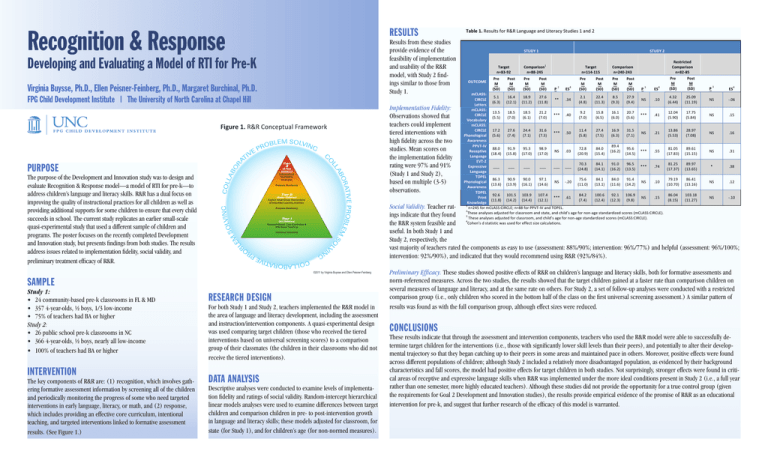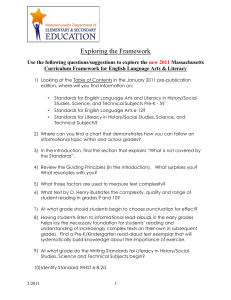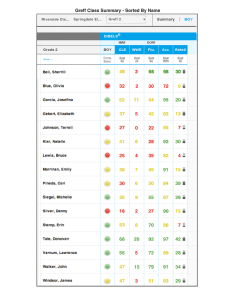Recognition & Response PURPOSE
advertisement

Recognition & Response RESULTS Results from these studies provide evidence of the feasibility of implementation and usability of the R&R model, with Study 2 findings similar to those from Study 1. Developing and Evaluating a Model of RTI for Pre-K Virginia Buysse, Ph.D., Ellen Peisner-Feinberg, Ph.D., Margaret Burchinal, Ph.D. FPG Child Development Institute | The University of North Carolina at Chapel Hill Tier 3 (A Few Children) R BO Individualized Scaffolding Strategies C A LL ATIVE PROBLEM Progress Monitoring Tier 2 (Some Children) LVING SO Explicit Small Group Interventions & Embedded Learning Activities Progress Monitoring Tier 1 (All Children) Research-Based Core Curriculum & Intentional Teaching B NG VI M LE Universal Screening SO L L ABORATI VE COL PR O The purpose of the Development and Innovation study was to design and evaluate Recognition & Response model—a model of RTI for pre-k—to address children’s language and literacy skills. R&R has a dual focus on improving the quality of instructional practices for all children as well as providing additional supports for some children to ensure that every child succeeds in school. The current study replicates an earlier small-scale quasi-experimental study that used a different sample of children and programs. The poster focuses on the recently completed Development and Innovation study, but presents findings from both studies. The results address issues related to implementation fidelity, social validity, and preliminary treatment efficacy of R&R. VE TI EM SOLVIN O BL G PR O PURPOSE COL LA BO RA Figure 1. R&R Conceptual Framework ©2011 by Virginia Buysse and Ellen Peisner-Feinberg SAMPLE Study 1: • 24 community-based pre-k classrooms in FL & MD • 357 4-year-olds, ½ boys, 1/3 low-income • 75% of teachers had BA or higher Study 2: • 26 public school pre-k classrooms in NC • 366 4-year-olds, ½ boys, nearly all low-income • 100% of teachers had BA or higher INTERVENTION The key components of R&R are: (1) recognition, which involves gathering formative assessment information by screening all of the children and periodically monitoring the progress of some who need targeted interventions in early language, literacy, or math, and (2) response, which includes providing an effective core curriculum, intentional teaching, and targeted interventions linked to formative assessment results. (See Figure 1.) RESEARCH DESIGN For both Study 1 and Study 2, teachers implemented the R&R model in the area of language and literacy development, including the assessment and instruction/intervention components. A quasi-experimental design was used comparing target children (those who received the tiered interventions based on universal screening scores) to a comparison group of their classmates (the children in their classrooms who did not receive the tiered interventions). DATA ANALYSIS Descriptive analyses were conducted to examine levels of implementation fidelity and ratings of social validity. Random-intercept hierarchical linear models analyses were used to examine differences between target children and comparison children in pre- to post-intervention growth in language and literacy skills; these models adjusted for classroom, for state (for Study 1), and for children’s age (for non-normed measures). Implementation Fidelity: Observations showed that teachers could implement tiered interventions with high fidelity across the two studies. Mean scores on the implementation fidelity rating were 97% and 91% (Study 1 and Study 2), based on multiple (3-5) observations. Table 1. Results for R&R Language and Literacy Studies 1 and 2 OUTCOME STUDY 1 Target n=83-­‐92 Pre M (SD) Post M (SD) STUDY 2 1 Comparison n=88-­‐245 Pre M (SD) Post M (SD) 2 P Target n=114-­‐115 4 ES Pre M (SD) Post M (SD) Comparison n=240-­‐243 Pre M (SD) Post M (SD) 3 P 4 ES mCLASS: 5.1 16.4 18.9 27.6 2.1 22.4 8.5 27.9 CIRCLE ** .34 NS .10 (6.3) (12.1) (11.2) (11.8) (4.8) (11.3) (9.3) (9.4) Letters mCLASS: 13.5 18.5 18.5 21.2 9.2 15.8 16.1 20.7 *** .40 *** .41 CIRCLE (5.5) (7.0) (6.1) (7.0) (7.0) (6.5) (6.0) (5.6) Vocabulary mCLASS: CIRCLE 17.2 27.6 24.4 31.6 11.4 27.4 16.9 31.5 *** .50 NS .21 Phonological (5.6) (7.4) (7.1) (7.3) (5.8) (7.5) (6.3) (7.1) Awareness 89.4 PPVT-­‐IV 88.0 91.9 95.3 98.9 72.8 84.0 95.6 NS .03 (16.2) *** .55 Receptive (18.4) (15.8) (17.0) (17.0) (20.9) (15.4) (14.5) Language EVT-­‐2 70.3 84.1 91.0 96.5 Expressive ___ ___ ___ ___ ___ ___ *** .74 (24.8) (14.1) (16.2) (13.5) Language TOPEL 86.3 90.9 90.0 97.1 75.6 84.1 84.0 91.4 NS -­‐.20 NS .10 Phonological (13.6) (13.9) (16.1) (14.6) (11.0) (13.1) (11.6) (14.2) Awareness TOPEL 92.6 101.5 103.9 107.4 84.2 100.6 92.1 106.9 Print *** .61 NS .15 (11.8) (14.2) (14.4) (12.1) (7.4) (12.4) (12.3) (9.8) Knowledge 1 n=245 for mCLASS:CIRCLE; n=88 for PPVT-­‐IV and TOPEL. 2 These analyses adjusted for classroom and state, and child’s age for non-­‐age standardized scores (mCLASS:CIRCLE). 3 These analyses adjusted for classroom, and child’s age for non-­‐age standardized scores (mCLASS:CIRCLE). 4 Cohen’s d statistic was used for effect size calculations. Restricted Comparison n=82-­‐85 Pre Post M M (SD) (SD) 3 P 4 ES 4.32 (6.44) 25.09 (11.19) NS -­‐.06 12.04 (5.90) 17.75 (5.84) NS .15 13.86 (5.53) 28.97 (7.08) NS .16 81.05 (17.83) 89.61 (15.15) NS .31 81.25 (17.37) 89.97 (13.65) * .38 79.19 (10.70) 86.41 (13.16) NS .12 86.04 (8.15) 103.18 (11.27) NS -­‐.10 Social Validity. Teacher ratings indicate that they found the R&R system feasible and useful. In both Study 1 and Study 2, respectively, the vast majority of teachers rated the components as easy to use (assessment: 88%/90%; intervention: 96%/77%) and helpful (assessment: 96%/100%; intervention: 92%/90%), and indicated that they would recommend using R&R (92%/84%). Preliminary Efficacy. These studies showed positive effects of R&R on children’s language and literacy skills, both for formative assessments and norm-referenced measures. Across the two studies, the results showed that the target children gained at a faster rate than comparison children on several measures of language and literacy, and at the same rate on others. For Study 2, a set of follow-up analyses were conducted with a restricted comparison group (i.e., only children who scored in the bottom half of the class on the first universal screening assessment.) A similar pattern of results was found as with the full comparison group, although effect sizes were reduced. CONCLUSIONS These results indicate that through the assessment and intervention components, teachers who used the R&R model were able to successfully determine target children for the interventions (i.e., those with significantly lower skill levels than their peers), and potentially to alter their developmental trajectory so that they began catching up to their peers in some areas and maintained pace in others. Moreover, positive effects were found across different populations of children; although Study 2 included a relatively more disadvantaged population, as evidenced by their background characteristics and fall scores, the model had positive effects for target children in both studies. Not surprisingly, stronger effects were found in critical areas of receptive and expressive language skills when R&R was implemented under the more ideal conditions present in Study 2 (i.e., a full year rather than one semester, more highly educated teachers). Although these studies did not provide the opportunity for a true control group (given the requirements for Goal 2 Development and Innovation studies), the results provide empirical evidence of the promise of R&R as an educational intervention for pre-k, and suggest that further research of the efficacy of this model is warranted.






